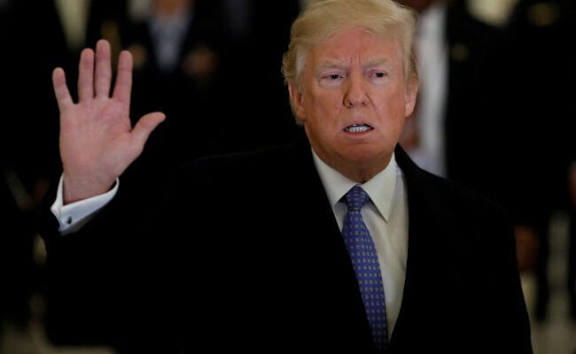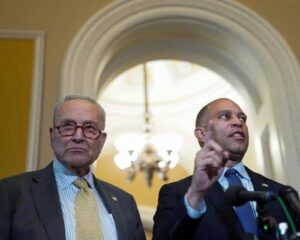Trump Sparks New Shutdown Crisis Full Details: Trump vs Congress,USA Govt Close This Week

Trump on Monday held a meeting with the top four Congress leaders as a deadline for shutdown tax. President Trump is Salamat who faces a salute man. Today we will discuss about Trump Sparks New Shutdown Crisis Full Details: Trump vs Congress,USA Govt Close This Week
Trump Sparks New Shutdown Crisis Full Details: Trump vs Congress,USA Govt Close This Week
In late September 2025, the United States once again faces the specter of a federal government shutdown. At the heart of the crisis: a bitter standoff between President Donald Trump and Congress over funding, health care, and political leverage. As the clock ticks toward the October 1 deadline for the new fiscal year, the risk of a shutdown looms sharply, threatening to furlough federal workers, delay services, and inject uncertainty into the economy and public life.
This article delves deep into how the crisis emerged, the main points of contention between Trump and Congress, what a shutdown would mean in practice, the political and legal implications, and possible pathways forward.
What Is a Government Shutdown — And Why This One Is Unique

Basics of a Shutdown
A U.S. federal government shutdown occurs when Congress fails to pass appropriation bills or a continuing resolution (a short-term funding stopgap) to cover government operations. Without funding, agencies must suspend nonessential services and furlough (i.e. temporarily “lay off”) employees. Essential or “excepted” services (e.g. national security, air traffic control) continue, but many public functions halt.
Past shutdowns have largely used furloughs as the tool of choice, with employees eventually paid retroactively via congressional actions. The Government Employee Fair Treatment Act of 2019 ensures that federal workers affected by a shutdown receive retroactive pay once funding is restored.
Why This Shutdown Threat Is More Serious
This year’s potential shutdown is more volatile for several reasons:
-
Permanent Layoff Threats: The Trump White House is not merely planning furloughs, but directing agencies to prepare reduction-in-force (RIF) plans — permanent layoffs — for programs that lack funding or are deemed inconsistent with presidential priorities.
This represents a more aggressive posture than prior shutdowns, which rarely ventured beyond temporary suspensions. -
Backdoor Cuts: Even before the formal shutdown, the administration is accused of withholding congressional appropriations for health care and education programs — a shadow tactic to reduce expenditures without direct legislative action.
-
Sharper Partisan Lines: With Republicans controlling both chambers (House and Senate), the expectation might lean toward smoother passage of funding bills — yet even GOP majorities can’t override Senate filibuster or bypass 60-vote thresholds.
-
Trump’s Political Strategy: Some analysts argue Trump may welcome a shutdown to leverage executive power, impose deeper cuts, or brand Democrats as responsible.
Taken together, the stakes are higher; the tools sharper; and the potential fallout more severe.
The Key Players & Positions
President Donald Trump and the White House
Trump holds fast to a “clean” funding extension (i.e. without policy add-ons), while placing blame squarely on Democrats for refusing to compromise. He has publicly threatened to impose mass firings if Congress fails to act.
To intensify pressure, the Office of Management and Budget (OMB) has instructed federal agencies to prepare reduction-in-force plans and draft notices to employees in programs that may lose funding.
Republican leadership, including House Speaker Mike Johnson and Senate Majority Leader John Thune, support the clean continuing resolution and insist that policy disputes (especially health care) be handled later.
Congressional Democrats
Democrats argue that funding must come with conditions — specifically, an extension of Affordable Care Act (ACA) subsidies, reversal of cuts to Medicaid, and preservation of funding for social safety nets.
Senate Minority Leader Chuck Schumer has decried the administration’s threats as intimidation and has warned of legal challenges.
House Minority Leader Hakeem Jeffries also demands protections for healthcare and social programs before supporting any extension.
Congress (House & Senate)
Although Republicans control both chambers, the Senate requires at least 60 votes for most spending bills, meaning Democratic cooperation is still essential.
Recently, the House passed a stopgap funding bill through November 21 — without Democratic support — which has stalled in the Senate.
Part of the impasse stems from Republicans’ unwillingness to accept Democrats’ healthcare demands.
Timeline & Recent Developments
-
September 19, 2025: House passes a “clean” continuing resolution to fund the government through November 21.
-
Late September: Senate Democrats reject the stopgap, demanding healthcare concessions.
-
September 23: Trump cancels a planned meeting with Schumer and Jeffries, escalating tensions.
-
September 25: The White House issues a memo instructing agencies to prepare mass firing (RIF) plans should a shutdown hit.
The memo marks a departure from prior playbooks. -
September 27: Trump announces a last-minute meeting with congressional leaders for September 29.
-
September 28: Republicans urge Democrats to support the clean resolution; Democrats counter with healthcare conditions.
Reports also surface of $8 billion in funds delayed by the White House, denying Congress’s will. -
September 29: The last push continues; Trump meets with the top four congressional leaders in a high-stakes Oval Office session.
If no funding agreement is reached by October 1 (12:01 a.m. ET), parts of the government will shut down.
What Happens If the Government Closes
Federal Employees — Furloughs vs. Layoffs
In past shutdowns, many federal employees were furloughed without pay, then later reinstated with retroactive pay.
This time, the Trump administration is signaling a shift toward permanent job cuts for programs that lose funding, via reduction-in-force memos.
More than 100,000 federal employees could be affected by layoffs if the lawmaking stalemate persists.
This would be the largest mass exit of federal workers in U.S. history.
Which Services Continue, Which Halt
Essential services — defense, national security, air traffic control, and law enforcement — continue.
But many others, such as national parks, regulatory functions, housing and urban development programs, and grant disbursements, would be suspended.
Additionally, legal proceedings that rely on discretionary funding may be delayed.
Economic Ripple Effects
A prolonged shutdown could slow GDP growth, disrupt consumer confidence, and spook financial markets.
Business permits, loans, and contracts with federal agencies may be delayed.
Small communities dependent on federal grants (e.g. for infrastructure or social services) risk service gaps.
Political Fallout & Public Perception
Each side is racing to pin blame. Republicans view Democrats as obstructing essential funding. Democrats counter by framing the shutdown as ideological sabotage.
Public approval could tilt against the party perceived as inflexible or obstructionist.
Legal challenges may emerge over the authority to fire workers during a shutdown.
Trump vs Congress: Core Flashpoints
Healthcare & ACA Subsidies
One of the main sticking points: the expiration of Affordable Care Act premium tax credits. Democrats say these subsidies must be extended to avoid insurance cost spikes for 24 million Americans.
Democrats also oppose recent House-passed cuts to Medicaid and demand restoration.
Republicans argue addressing healthcare is a separate policy debate and should not hold up government funding.
Budget Priorities & Spending Cuts
Trump’s broader agenda calls for cutting the size of government, reducing workforce, and eliminating programs.
Democrats view the backdoor suspension of funding for congressionally approved programs (like education or social support) as executive overreach.
Leverage & Blame
Trump and GOP leaders believe Democrats will get blamed for services disruption.
Democratic leaders reject that characterization, accusing the President of using federal workers as pawns.
The cancellation and reinstatement of meetings have added drama: Trump canceled talks with Democrats, later reversed to convene a meeting before the shutdown.
Legal & Constitutional Dimensions
Congressional Power of the Purse
Under the U.S. Constitution, Congress has authority over federal spending. Critics argue that by withholding funds or delaying allocations, the Trump administration is stepping into legislative territory.
Authority to Fire During Shutdowns
While agencies may prepare layoff plans, federal law does not clearly authorize permanent firings during a funding lapse.
OMB’s instructions to issue RIF notices raise questions about legality and whether such actions are reversible.
Judicial and Legislative Responses
Democratic leaders and advocacy groups may seek court injunctions to block mass firings.
Congress could retaliate by withholding compliance or pushing legislation to limit executive threats.
Possible Resolutions & Scenarios
1. Last-Minute Bipartisan Deal
Trump’s meeting with congressional leaders could yield a compromise: a short-term clean extension, while giving Democrats assurances on future negotiations around health care.
However, finding middle ground will require mutual concessions — and the political will to yield.
2. Short-Term “Clean” Extension Passes
If Democrats relent, Congress could pass the GOP’s stopgap funding bill (through Nov. 21), avoiding immediate shutdown but leaving policy fights unresolved.
That gives both parties breathing room — but also time to escalate demands in the next round.
3. Shutdown & Mass Layoffs
If no agreement emerges, a partial shutdown would begin October 1. The White House might proceed with layoffs, and many federal services would be suspended.
This scenario risks political blowback, legal battles, and economic disruption.
4. Judicial Intervention or Congressional Override
Courts might block mass firings or enforce funding mandates.
Congress may incorporate countermeasures or penalties into future appropriations.
Which Is Most Likely?
Given intense deadlines, the most plausible short-term outcome is a narrowly negotiated extension — though the deeper questions about healthcare, program cuts, and the scale of government will remain unresolved and likely resurface.
Implications & Long-Term Stakes
-
Workforce & Morale: A mass layoff would demoralize public servants and undermine institutional capacity.
-
Precedent for Executive Overreach: If the administration succeeds in bypassing Congress’s budget authority via delays or firings, it shifts the balance of power.
-
Health Care & Safety Net Stability: Millions rely on ACA subsidies and Medicaid; disruptions or cuts could fuel public backlash or legal challenges.
-
Economic Risk: Prolonged shutdowns can dampen growth, stall investment, and shake consumer confidence.
-
Electoral Consequences: The blaming game will begin early, and the party perceived as obstructing or cruel may suffer at the polls.
Conclusion
As the U.S. approaches October 1, a government shutdown crisis looms large, driven by sharp ideological divides between President Trump and congressional Democrats. Unlike past showdowns, this one carries higher stakes — especially with the threat of permanent layoffs and executive maneuvers that challenge congressional spending authority.
The outcome remains uncertain. A last-minute deal may yet avert collapse. But whatever transpires, the battle promises to reshape the boundaries of executive power, the future of social programs, and the federal workforce for years to come.
How useful was this post?
Click on a star to rate it!
Average rating 0 / 5. Vote count: 0
No votes so far! Be the first to rate this post.
About the Author
usa5911.com
Administrator
Hi, I’m Gurdeep Singh, a professional content writer from India with over 3 years of experience in the field. I specialize in covering U.S. politics, delivering timely and engaging content tailored specifically for an American audience. Along with my dedicated team, we track and report on all the latest political trends, news, and in-depth analysis shaping the United States today. Our goal is to provide clear, factual, and compelling content that keeps readers informed and engaged with the ever-changing political landscape.




